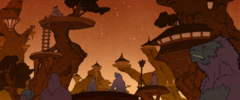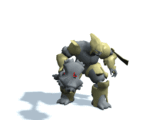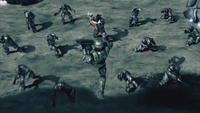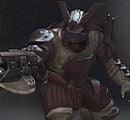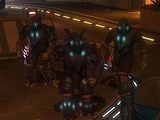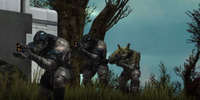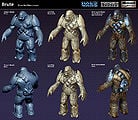Jiralhanae
From Halopedia, the Halo wiki
| This article does not meet the wiki's general standards and/or standards on layouts. You can help by cleaning this article. |
- "With my blessing, the Brutes now lead our fleets! They ask for your allegiance, and you shall give it!"
- — Prophet of Truth
The Jiralhanae (Latin, Servus ferox, translated to "wild slave"[1]), known by humans as Brutes, are the newest race to join the Covenant. They are a species of carnivorous, mammal-like aliens from Doisac.
The Jiralhanae were the second Covenant species encountered by the humans following the Kig-yar raid on the freighter This End Up. They were also the first Covenant species encountered by the Harvest Colonial Militia. The Brutes have a profound hatred of the Sangheili, unmatched by any other feud within the Covenant, fueled by the Jiralhanae's naturally aggressive demeanor and the Sangheili's natural sense of superiority (presumably viewing the Brutes as "savages").
Description
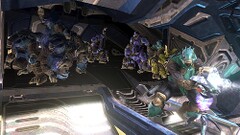
Jiralhanae are mammalian in appearance and share physical characteristics with Earth's gorillas, rhinoceros, and bears; due to their bear-like features, they are designated as pseudo-ursines.[2] They have thick, gray skin, and are covered with matted black, tan, or brown fur. The majority of Jiralhanae shave their fur, with higher-ranking individuals sporting beards or mohawks. Their large, stocky appearance is most likely due to the gravity on their planet, which is about twice the gravity of that on Earth. As they age, the hair will change to a grayish-silver color.
Jiralhanae are immensely strong, hence the "Brute" moniker, and are capable of delivering crushing blows in hand-to-hand combat. Their teeth are very sharp, and are frequently used as natural weapons. In battle, they are prone to fits of berserk rage, and will proceed to rush at and pummel any targets within reach with terrifying aggression.
Jiralhanae are obviously carnivores, given their fearsome fanged jaws and propensity for violence. It has been stated that they feed on the flesh of their enemies, such as the Humans they face in battle and have been seen eating the meat of a Thorn Beast, apparently considered a delicacy among Brutes.[3] A Brute once stated he would have gladly devoured the future Arbiter, had he been allowed.[4]
The Jiralhanae are rated a Native Tier 4/Adopted Tier 2 species by the Forerunner Technological Achievement Tier scale.[5]
History
The Ark and Reseeding
The Jiralhanae were one of many sentient species indexed by the Librarian for preservation aboard Installation 00. After the Halo Array was fired, the Jiralhanae were returned to Doisac to begin re-building their culture.
The Covenant
Despite their savagery, Jiralhanaae proved intelligent enough to achieve spaceflight and space-faring status, though their warlike nature caused them to collapse into a devastating war. They had recently concluded a mechanized war of attrition between the Master Packs which took they back to a pre-industrial state when the Covenant discovered them in 2492. They had just rediscovered radio and rocketry and in their primitive state, they were quickly defeated and absorbed into the Covenant.[6]
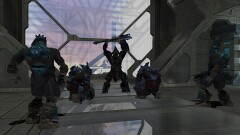
Post-Covenant
The exact fate of the Jiralhanae race after the disastrous defeat at the Ark is unknown, though it is extremely unlikely that they would surrender or retreat, or that the Sangheili would allow them to, though some surrendered and were willing to work for the Sangheili. A Sangheili Shipmaster visiting Kholo noted that at least some Jiralhanae factions had separated from the Covenant, waging an internecine war against each other and when the remaining San 'Shyuum retreated into hiding, they returned to their primitive savage nature, allowing the Sangheili to gain the upper hand in battle.[7] There were several Jiralhanae, such as Manus and the crew of the Piety, who remained loyal to their Sangheili commanders after the split of the Covenant.[8]
Anatomy and physiology
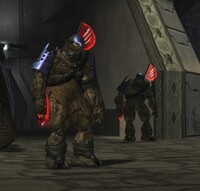
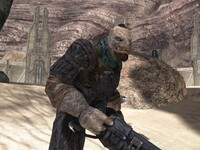
Brutes are physically imposing enemies to face in combat. Standing at approximately 9 feet tall, they not only tower over their human opponents but the majority of their Covenant allies with only Mgalekgolo standing taller. They have thick, gray skin that is extremely resilient to damage.
In their first appearance, they are covered in thick, shaggy fur that offers further protection. It covers most of the body except for the head and the shoulder blades. However, in Halo 3 and Halo: Reach they appeared to be shaved. They are seen with shaven faces which increases the fearful effect they have on opponents. In Halo 3, the Brutes have what looks like scales on their arms but it may have been extensions to their armor, or simply their thick skin as seen in the McFarlane action figures. Brutes exhibit two colorations: brown and gray. This is perhaps an indication of age, since lower ranking Brutes are brown and most Honor Guards are grey, Tartarus included.
In Halo 3, Brutes have mixed red-and-blue blood. At first glance it appears red, but upon closer inspection one would see blue spots in pools of Brute blood. At a casual glance, it appears purple. In Halo 2, however, it appeared black. In Halo: Reach, Brutes have red blood, similar to humans. Brutes resemble a cross between an ape and a rhinoceros, being taller and more muscular than humans.
Heavily muscled and possessing animalistic brutality and strength, Brutes can rely on close combat to defeat their enemies, even more so than their Elite counterparts. However, their great strength may in fact be simply relative, due to the species' evolution on a world with twice the gravity of Delta Halo, Earth, and other planets and structures with one G. Featuring characteristics both simian and ursine, their appearance fits their human given name. Their heavy muscles gives them at least enough strength to be able to snap a Human Marine's neck in one punch.[9]
Brutes have 3 digits on each hand including opposable thumbs. As such they can make use of a variety of weapons both of Covenant and human design. Their feet have only two digits. When it comes to ranged conflict, Brutes show a tendency to use large, rapid firing, often powerful weapons. This may be indicative of their mentality, and by extension their brutal nature. The many spikes and serrated edges that adorn their race's weapons, vehicles and armor further support this. It is interesting to note that in Halo 2 Jiralhanae can be seen using human shotguns. Brutes sometimes wield their own handgun-style shotguns called Maulers in Halo 3.
Brutes are not as mentally slow as they appear to be, and can often be fairly cunning tacticians. As such they can pilot vehicles and ships as well as command armies and fleets with strategic competence, albeit lacking in artistic flair. They also have a more sophisticated vocabulary than other members of the Covenant apart from Elites and Prophets.
Brutes are known to descend into a highly aggressive berserk-like rage when all their pack mates have been killed. Their incredible physical strength coupled with a dogged self determination to kill their target makes a berserk Brute a force to be reckoned with, being powerful enough to even kill Hunters [citation needed]. When berserking, they will not hesitate to attack an enemy even if the target is in a vehicle such as a Ghost. If the target is in a vehicle, they will attempt to board and kill the driver of said vehicle. Interestingly, they will neither attack nor hijack a low flying vehicle (such as a Banshee).
There is a substantial difference between the Brutes before and after the Great Schism. Pre-Great Schism Brutes had very little armor, were unclothed and unshaven. Post-Great Schism Brutes were largely shaven, clothed in tight-fitting garments that reflected their rank and were adorned with Jiralhanae power armor. This probably had something to do with the Brutes' new-found rank after the Elites' split from the Covenant.
Given the absence of power armor on the Brutes on Installation 05, it is possible that the Brutes that were seen were members of Tartarus's pack and/or a subset of the Jiralhanae that shunned the use of extensive protection and emphasized relying on their own strength, skill, courage, and ferocity to protect them, or that all the Brutes on Installation 05 are from Maccabeus/Tartarus' clan and were banned from wearing armor due to their failure at Harvest.
It is also possible that the Brutes on Installation 05 were second in rank to the Elites and the Prophets. Following the Great Schism, the Brutes became the Prophets' main protection, and it became a necessity to outfit them with more advanced equipment.
In Halo: Contact Harvest, it is stated that before Jiralhanae reach full maturity, they naturally release pheromones. Other Jiralhanae can smell these pheromones and tell how others are feeling by the scent. When they do reach maturity, they learn to control the releases of their pheromones and most likely stop them all together.
Culture
Brutes are extremely zealous creatures, known for their willingness to cling to ancient, bloody traditions and their unwavering belief in the words of the Prophets and in the promise of the Great Journey. Their home world is war-torn, and Brutes are known for their particular joy in vicious activities, complimented by regimented discipline.
As part of the Covenant, Brutes were required as a prerequisite to convert to the Prophets' religion of worshiping the Forerunners. Previously, their culture revolved around the worship of totems and idols, but they made swift converts.[5] The Brutes are now the most fanatical adherents to the Prophet's faith, although they seem to hold little concept of sanctity, evidenced by Tartarus' handling of the "Oracle".
They prefer using weapons from their homeworld, rather than the Covenant standard-issue plasma-based firearms. Brute weapons are notable for being extremely dangerous, somewhat primitive and brutal, and always featuring a blade attachment such as the Spiker, Mauler, Brute Shot, and the Gravity Hammer. These weapons show their barbaric nature, for example, the fact that all of the weapons are named after ways of injury or causing bodily harm to another being. Although they do have their own type of Plasma Rifle, it is only found in Halo 2 and Halo 3: ODST (the rifle is red, but fires twice as fast as its blue counterpart, also causing it to overheat twice as fast). This type of Plasma Rifle was removed in Halo 3, being replaced by the Spiker.
In general, Brutes have a pronounced dislike of the Sangheili, due to the fact that they believe that they are better protectors of the Prophets than the Elites. The Prophet of Truth took advantage of this to ignite the Great Schism during the events of Halo 2. However, it appears that at least some Jiralhanae have surrendered and are willing to serve the Sangheili after the end of the war.[10]
Society
Brutes society is dominated by a fierce pack culture and lineage, a close knit affair that ties each member to another, and forces them into varying states of rage known as "berserking", and desperate mourning for their fallen pack mates should one die in the midst of battle. What a pack member kills may be the food of the pack. There is certainly a patriarchal scheme that is followed loosely, depending on the social, martial, and sexual success of the patriarch. Patricide is an unfortunate side effect of patriarchy. No females have been observed in military roles.
Each pack is led by a prominent Brute Chieftain that wields a ceremonial Gravity Hammer, passed from one leader to another upon his death, to denote his status. A Brute becomes a pack Chieftain by challenging the current Chieftain to a mortal duel; the victor claims the title after executing the other. The chieftain rules his pack like his own little empire. Their warrior culture is extremely patriarchal, with rank measured by success on and off the battlefield, unlike the Sangheili.[5]
It is unlikely, given their combative and aggressive nature, that the Jiralhanae have a single cohesive government. Instead, Jiralhanae society can be viewed as an extension to the simply pack structure, but with a number of different levels:
- Alpha Tribes - seem to be the political body of the Jiralhanae, and are comprised of smaller Master Packs. Lead by Alpha Jiralhanae.
- Master Packs - more military oriented groups, Master-Packs are comprised of many smaller packs. Prior to contact with the Covenant, rival Master Packs reduced Jiralhanae society to a preindustrial level through warfare.
- Packs - range in size and importance, with less important packs made up largely of Unggoy or Kig-yar forces and led by a low-ranked Jiralhanae, and more important packs led by War Chieftains and comprised of more experienced veteran Jiralhanae bodyguards.
Jiralhanae exhibit a variety of facial-hair configurations to denote their status, as well as possibly what pack they belong to. Jiralhanae typically are either clean shaven or sport mohawks, goatees or beards. Chieftains frequently posess large mohawks as in the case of Tartarus and long, braided beards. However, some Jiralhanae packs do away with shaving altogether and sport long fur over most of their body, as seen during the events on Installation 05.
Some Jiralhanae packs also adorn themselves with tattoos over their entire bodies.
Role within the Covenant
Whereas the Sangheili command the Covenant's military and serve as the personal protectors of the San'Shyuum, the Jiralhanae primarily serve as the Covenant's shock troops and secret police. They are typically deployed in packs led by one or more Chieftains or Captains.
The Jiralhanae fill a similar role in combat to the Sangheili, as they are both typically command groups of lesser Covenant infantry. However, Jiralhanae are generally not equipped with energy shields (except for Captains and Chieftains, and all Jiralhanae post-Great Schism) and wield a slightly different arsenal of weaponry.
Jiralhanae troops often seem to be sent in after Elites have failed their task. Examples of this are the assault on the Forerunner Artifact beneath SWORD Base, in which Brutes were sent in after waves upon waves of failed Elite troops. This may allude to the Prophets attitude of Brute favoritism, something that would eventually lead to the replacement of Elites by Jiralhanae in Halo 2 after the Prophet of Regret is killed by the Master Chief.
It is also important to note that the covenant fleets are mostly segregated, with Elite fleets and Brute fleets not intermixing. This is probably done to prevent authority issues within the ranks. These fleets did battle during Great Schism, around the infested High Charity and Delta Halo. During the events of Halo 3, the Jiralhanae had completely replaced the Elites, who had left the Covenant and formed the Separatists.
Naming
Most known Jiralhanae have Latin-sounding names, such as Tartarus and Bracktanus. In Contact Harvest, it is revealed that the "-us" at the end of their name is an honor denoting maturity or experience in battle (similar to the "-ee" suffix on Elite's names.) However, it is possible that different naming conventions are used among different tribes, as evidenced by the names of Gargantum and Parabum.
Homeworld
- Main article: Doisac
Doisac is the name of the Jiralhanae home world. It possesses three satellites: Warial, Solrapt, and Teash, and is the fourth planet of the Oth Sonin system. The gravity on the planet is approximately 2.1G while the atmosphere is 1.3 ATM. Surface temperature is between -15'C to 52'C. The estimated population of the planet is approximately 12.5 billion. Its habitat is described as being dominated by magma and magnetism.[5]
Rank Structure
The Brute species is arranged in a pack society, based on a hierarchy determined by viciousness and number of war kills. A “pack master” leads brute packs. A chieftain will frequently be addressed as such while issuing orders during combat. In Halo 2, the ranks were mostly determined by red flags on their backs, the amount of armor they wore and the color of their fur (sometimes even their weapons). Like the Elites, ranks in Halo 3 are differentiated by armor color. Furthermore, the higher the rank, the more advanced and resilient the armor becomes.
| Rank | Image | Description |
| War Chieftain | File:H3 Brute Chieftain Armor.gif | These Brute Chieftains rely upon powerful weapons like Portable Plasma Cannons and Fuel Rod Guns to crush their foes, while often throwing or possessing Power Drains and Flares. Their armor cannot be stuck by Plasma Grenades/Spike Grenades or Needler needles. However, they can be stuck by Incendiary Grenades or their weapon can by any sticking grenade for an immediate kill. Identification: Dark Golden Armor. |
| Chieftain | File:H3 Brute Chieftain Weapon.gif | These Brute Chieftains are clad in crimson/black armor and wield close-ranged Melee weapons such as Gravity Hammers. They use Invincibility, a Power Drainer, or a Flare and their Power Armor cannot be stuck by Plasma/Spike grenades or Needler needles. However, they can be stuck by Incendiary Grenades. Also, their weapon can be stuck by any sticking grenade. Often on easy or normal difficulty these brutes aren't as accurate with there gravity hammers and often sloppy. When the difficulty is on heroic or legendary they are a lot more accurate and can easily crush their opponents. Identification: Black and Red Armor. |
| Brute Captain Ultra | File:H3 Brute Captain Ultra.gif | The Brute Captain Ultras are the highest captain rank and use heavier weapons, such as Brute Shots and Fuel Rod Guns. Identification: Cyan/Cobalt Armor. |
| Brute Captain Major | File:H3 Brute Captain Major.gif | The Brute Captain Majors are even more experienced than their younger comrades and lead larger packs into battle. Also usually wield Brute Shots and Fuel Rods Identification: Golden Armor. |
| Brute Captain | File:H3 Brute Captain Minor.gif | The Brute Captains are experienced Brutes who now lead their comrades and the lesser races into battle. Identification: Purple-Red Armor. |
| Brute Honor Guard | File:Guardsmen2.png | Brute Honor Guards were chosen by the Prophets to replace the Honor Guard Elites as their protectors after murder of the High Prophet of Regret. They are exclusive of Halo 2 and are some of the best warriors the Brutes have. Identification: Orange, Yellow and Red Ceremonial Armor; Red Flag. |
| Brute Bodyguard | File:H3 Bodyguard.gif | Brute Bodyguards are some of the Chieftain's most reliable warriors and not only protect their chieftain but enforce his tribal law. They seem to be the Halo 3 Brute counterparts of the Honor Guard Elite Unit. Identification: Grayish-Blue/Steel Blue armor. |
| Jump Pack Brute Captain | File:Bruteultra.gif | These veteran Brutes utilize jump packs to launch aerial attacks from afar, and use their enhanced mobility for guerrilla battle tactics. They seem to be the Brute counterparts of the Ranger Elite Unit. Identification: Jump pack, Gold armor. |
| Jump Pack Brute Major | File:Brutemajor.gif | These veteran Brutes utilize jump packs to launch aerial attacks from afar, and use their enhanced mobility for guerrilla battle tactics. They seem to be the Brute counterparts of the Ranger Elite Unit. Identification: Jump pack, Red armor. |
| Jump Pack Brute Minor | File:H3 Brute Jumppack.gif | These veteran Brutes utilize jump packs to launch aerial attacks from afar, and use their enhanced mobility for guerrilla battle tactics. They seem to be the Brute counterparts of the Ranger Elite Unit. Identification: Jump pack, Blue armor. |
| Brute Stalker | File:H3 Brute Stalker.gif | Brute Stalkers are the secret police of the Brutes and specialize in stealth techniques with their Active Camouflage generators. They seem to be the Brute counterparts of the Stealth Elite unit. Identification: Grayish Black armor, Flame Grenades, Radar Jammers, Maulers. |
| Brute Ultra | File:H3 Brute Ultra.gif | Brute Ultras are now armed with violet Armor, they are comprised of the best of the regular infantrymen, showing tact, cunning skill and strength. Identification: Purple-Blue/Indigo armor. |
| Brute Major | File:H3 Brute Major.gif | Brute Majors are clad in dark blue Armor and are promoted in a similar fashion to the Elites. They are promoted on the casualties they inflict. Identification: Blue armor. |
| Brute Minor | File:H3 Brute Minor.gif | Brute Minors are the lowest rank of the Brute race, clad in turquoise Armor and typically armed with the Type-25 Carbine. Not only do they compete for their posting but also for their equipment. Identification: Teal-Green armor, unarmored in Halo 2. |
Also in Halo 2, Brute Minors are seen with little to no armor, the only armor being a helmet-like head plate which, ironically, gives no protection from headshots from even the weaker weapons such as the Plasma Pistol and Magnum. It is known they do not switch weapons at any time.
Other Ranks
Chieftain of the Jiralhanae - The Leader of the entire Jiralhanae race. Both Maccabeus and Tartarus were of this rank. Since Tartarus was killed in the Battle of Installation 05, the current Chieftain is unknown, if there is one at all.
Brute Ship Master/Alpha Jiralhanae - Commanders of ships. They may be equivalent to Captains or Chieftains of the Jiralhanae.
Jiralhanae Army Commander - Only in Halo Wars, probably same rank or near same rank as Chieftain of the Jiralhanae. May be a specific rank created for war and conflict, such as the Human-Covenant War.
Trivia
Template:Quotes Link Template:Gameplay
- According to the original printing of Halo: First Strike, the Jiralhanae were first encountered by SPARTAN-II personnel aboard the Unyielding Hierophant in 2552. Since the release of the novel, numerous sources have clearly demonstrated that the Jiralhane were encountered throughout the war. The 2010 re-release of Halo: First Strike removes such references to the Brutes being an as yet un-encountered species.
- The word "Jiralhanae" is a Korean curse word that roughly means "stupid, aggressive lunatic", which describes the Brutes' aggressive personality to a tee.
- Despite having been absorbed into the Covenant in 2492, Halo: Ghosts of Onyx describes the feud between the Jiralhanae and the Sangheili as "ancient".[11]
- In the ViDoc, Et Tu Brute, Chris Butcher describes the Brutes in Halo 2 as "damage sponges", referring to how they weren't very interesting to fight against, acting mainly like less agile Elites who dropped their guns and ran straight toward the player when they got angry. The ViDoc shows Brutes wielding energy swords; however they are never seen doing so in-game. Et Tu Brute also shows a Brute Minor with a Brute Shot using the corpse of another Brute as cover from which to fire from, and another tearing the arms off a captured Marine. Additionally, a Brute Chieftain wielding a plasma cannon wields the version from Halo 2. This is because Bungie was using it as a placeholder until they developed the Halo 3 model.
- In the Et Tu Brute ViDoc, it is revealed that the Brutes' original concept was inspired by the barbarians that plagued ancient Rome and eventually became assimilated into it. Marcus Brutus betrayed and killed Julius Caesar and was later hunted down by Rome. This is similar to how the Brutes betrayed the Elites and were eventually defeated. The "-us" suffix on the end of Brute names is a Latin ending denoting a second declension nominative singular noun.
- During concept stages for Halo 3, the Brutes were planned to use deployable metal shields, rather than the energy shields used by Elites. This idea was eventually cut from the final game, although it would inspire the Brutes ducking animation.[12]
- Before Halo 3 was released, Brutes had lime green blood instead of the dark red blood they have in the final game.[13]
- In Halo 3: ODST the power armor of the Brutes completely lights up, similarly to Elite and SPARTAN energy shields, instead of small sparks marking where gunfire hits their armor like in Halo 3.
- In Halo 2, Jiralhanae blood is a dark shade of blue, while it is red with blue splotches in Halo 3, and is red in Halo: Reach.
- John DiMaggio provided the voice of the Jiralhanae chieftains in Halo 3 and Halo 3: ODST.
- In the level Anders' Signal in Halo Wars, Serina identifies the Jiralhanae using the actual name of the species, as well as calling them Brutes. This is the first time a Covenant species' actual name is spoken in scripted dialogue.
- Although the Brutes speak English in Halo 2, Halo 3, Halo Wars and Halo 3: ODST, they do not do so in Halo: Reach. This was a deliberate design choice intended to reinforce the alien nature of the Covenant, and to emphasize the Covenant's role as the greatest threat to humanity before the discovery of the Flood.
- The cancelled untitled Halo MMO was to feature female Brutes for the first time in Halo media.
Glitches
- Main article: Glitches
- In Halo 2, if a berserk Brute charges into a group of fixed objects it will continue its charging animation, but it will remain where it is.
- In Halo 3, if any Brute becomes infected by the Flood it will turn into a Flood-infected Brute Minor due to graphical restraints, and to time constraints. However, if the player triggers a loading point that removes the Flood from the level while a infection form has begun the infection process, the Flood Infection Form will be deleted, the infection process will be stopped yet the transformation will simultaneously complete. This will result in infected Brutes who are allied with the Flood while retaining berserking, appearance, and hijacking abilities. The only noticeable Flood features are signs of Flood infection growing on their back.[14]
- In Halo 3, if a Brute Chieftain with a plasma cannon goes berserk, the weapon disappears. When a Brute chieftain is killed, the plasma cannon reappears by its body. This is because the weapon has no "putting away" animation. However, this was fixed in Halo 3: ODST - if a chieftain goes berserk, the plasma cannon will hang across his back just like a normal two-handed weapon.
- In Halo 3: ODST, if one looks closely, a Brute with a Brute Plasma Rifle will appear to reload the weapon after using it for awhile, by reaching toward his left calf and seems to be doing the reload animation for a Spiker. This is not possible however, because the rifle is run by a plasma battery.
List of appearances
|
Gallery
- 285910 f260.jpg
A few examples of Jiralhanae weaponry.
- Jiralhanae concept.jpg
Early concept art for Halo 2.
An artistic take of a Jiralhanae, facing an Orbital Drop Shock Trooper.
- Reach - Brute concept 02.jpg
Concept art for Halo: Reach.
- Reach - Brute concept 01.jpg
Concept art for Halo: Reach.
- 1207645687 1166618976.jpg
A Jiralhanae Chieftain wielding an energy sword in a preview of the development of Halo 3.
Various Jiralhanae ranks as seen in the "Starry Night" trailer.
A Jiralhanae as seen in the Bestiarum.
A pack of Jiralhanae patrolling the main streets of African mega-city New Mombasa (Halo 3: ODST).
A pack of Jiralhanae on Caracalla Park in New Alexandria (Halo: Reach).
- Brute 1024.jpg
A Jiralhanae Army Commander, circa 2531 (from Halo Wars).
- 1775173-gallery.png
Renders from The Package.
Sources
- ^ halo.bungie.org: Bestiarum Latin names translated
- ^ Halo: Reach official website - Enemies - Brute
- ^ Halo: Contact Harvest, page 195
- ^ Halo 2, campaign level The Arbiter ("Them? What about us? My belly aches, and his flesh is seared just the way I like it.")
- ^ a b c d Cite error: Invalid
<ref>tag; no text was provided for refs namedBES - ^ Halo: Contact Harvest, page 194
- ^ Halo: Evolutions - Essential Tales of the Halo Universe, "The Return"
- ^ Halo: Glasslands, page ???
- ^ Halo 3 level Sierra 117
- ^ Halo Waypoint - Halo: Glasslands excerpt, Chapter 2
- ^ Halo: Ghosts of Onyx, page 193
- ^ Bungie.net: A Certain Sense of Movement
- ^ Halo 3 ViDoc: Et Tu, Brute?
- ^ YouTube: Halo 3 Glitch - Half Infected Brutes
